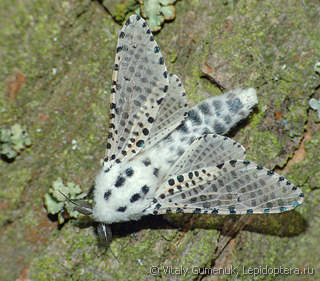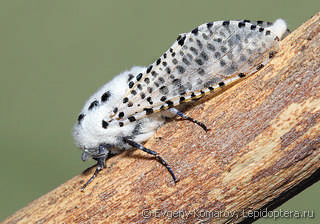Zeuzera pyrina (Linnaeus, 1761)

Taxonomy
class Insecta → subclass Pterygota → infraclass Neoptera → superorder Holometabola → order Lepidoptera → superfamily Cossoidea → family Cossidae → subfamily Zeuzerinae → genus Zeuzera → species Zeuzera pyrina
Species name(s)
Zeuzera pyrina (Linnaeus, 1761) = aesculi (Linnaeus, 1767) = Zeuzera decipiens Kirby, 1892. [9, 10]
Leopard Moth.
urn:lsid:insecta.pro:taxonomy:2928
Expansion
This species marks on the maps: 4.
Zoogeographical regions
Palaearctic, Nearctic.
Russia regions
#4. Evropeisky Severo-Zapadny*; #8. Evropeisky Tsentralny; #9. Evropeisky Tsentralno-Chernozyomny; #10. Sredne-Volzhsky; #11. Volgo-Donsky; #12. Nizhnevolzhsky; #13. Zapadno-Kavkazsky; #14. Vostochno-Kavkazsky; #17. Yuzhno-Uralsky; #20. Yuzhno-Zapadnosibirsky*.
* An asterisk denotes a region for which the species is listed as an migrant or information that requires additional checking.
Forewing length
16—35 mm.
Wingspan
65—70 mm.
Primary colors
Yellow, Brown/Gray/Black, White.
Flight time
| January | February | March | April | May | June | July | August | September | October | November | December |
Larva lifespan
| January | February | March | April | May | June | July | August | September | October | November | December |
Over-wintering stage
Larva.

Detailed information with references
Distribution
- Albania, Austria, Belgium, Bulgaria, Great Britain, Hungary, Germany, Denmark, Greece, Spain, Italy, Corsica, Crete, Latvia, Lithuania, Luxembourg, Malta, Netherlands, Norway, Poland, Portugal, Romania, Sardinia, Sicily, Slovakia, USSR - the European part of Turkey - European part of France, the Czech Republic, Switzerland, Sweden, Estonia, Yugoslavia. [1].
- Albania, Andorra, the Balearic Islands, Belarus, Belgium, Bulgaria, Bosnia and Herzegovina, the British Isles, France, Germany, Gibraltar, Greece (mainland), Denmark (mainland), Dodecanese Islands, Spain (mainland), Italy (mainland), Cyprus, Corsica, Crete, Latvia, Lithuania, Luxembourg, Macedonia,Malta, the Netherlands, Norway (mainland), the Channel Islands, Poland, Portugal (mainland), Romania, Russia, Sardinia, North Aegean Islands, Sicily, Slovakia, Slovenia, Turkey (European part), Ukraine, Finland, France (mainland part), Croatia, Cycladic, Czech Republic, Switzerland, Sweden, Estonia,Yugoslavia. [10].
- Regions of the Russian Federation: the Volga-Don, East Caucasus, the European North-West (?), The European Central Black Earth, Central European, Western Caucasus, Lower Volga, Mid-Volzhsky, South West Siberian (?), South Ural. [3].
- The whole of Europe. [5].
Imago Habitus and Differences from alike species
- Length of front wing - 1,6-3 cm. The females reach up to 3.5 cm. Painting white with black spots of different sizes, on the back of 6 blue spots, similar to the dice. The antennae of males - comb up the middle. [5].
- The wingspan of up to 70 mm. Butterfly white, in small angular blue-black spots. [11].
General info about Imago
- Parks and avenues, the neighborhood of mixed forests - a meeting place with a butterfly. Corrosive drevesnitsa active at night, when she can successfully catch the light. Butterflies do not fly often, even when grossly disturbed. [5].
- Moths fly hard. [11].
Imago lifespan
- Beginning of June - the end of August. [5].
- From June to July. [11].
General info about Larva
- Although the larvae of this moth for behavior similar to caterpillarsCossus cossus, they penetrate into the wood immediately after hatching from eggs and moves done in the smaller branches, moving as they mature into larger, but still remain within the young shoots. Track dorostayut only up to 4 cm in thickness and they are less larvae Cossus cossus.Live caterpillars at least 2 years. [5].
- Caterpillar yellowish-white, with black hairy tubercles. Larvae length - 60 mm. Young caterpillars bites in the shoots and leaf petioles and in the kidneys, gnawing them from the inside. In the autumn the larvae move on young branches, which gnaw tunnels under the bark and hardwood.Wintered here, the tracks go in the spring to a thick branch or to the trunk, where during the summer sharpen their final moves. The course consists of a broad inlet chamber and exhaust from it in wood Channel, which soon goes up. Here, the caterpillar will be winter again.Next spring the larva drevesnitsy bring progress to the full-length (14-20 cm) and a width of 1 cm and pupate in the upper part of the channel, cut off its transverse partition.
Caterpillar provides its course clean and throws out a bowel movement (as it may be contaminated uzant tree). [11].
Larva food plants / other food objects
- Salix, Corylus, Quercus, Acer, Alnus, Fagus, Fraxinus, Crataegus, Prunus, Malus. [28].
- Often - buckeye. And generally - larvae were found 150 species of deciduous trees. [5].
- Maple, lime, apple, beech, elm, ash and other deciduous trees, rarely - coniferous (spruce). [11].
Larva lifespan
- Caterpillars live from August to April. [5].
Pupa
- Pupation occurs in one of the moves within the timber escape for dolls are characterized by high mobility - before the release of half of adults they protrude outwards. [5].
Egg
- Females lay eggs Zeuzera pyrina not without the help of a long ovipositor, one by one, into the cracks of the bark of trees. [5].
- Eggs are laid mainly on the tops of the trees, they are glued to the female alone bark of young shoots. [11].
Overwintering stage
- Caterpillar. [5].
- Caterpillar twice. [11].
Subspecies of Zeuzera pyrina
- Zeuzera pyrina biebingeri (W. & A. Speidel, 1986). [10]
- Z. p. pyrina (Linnaeus, 1761). [10]
Authors
Initial species uploading to the site: Peter Khramov.
Photos:
Vitaly Gumenuk, Evgeny Komarov. Text data: Peter Khramov.
The species characteristics formalization: Peter Khramov, Sergei Kotov.
References
- [1] O. Karsholt, J. Razowski (eds.), 1996. The Lepidoptera of Europe: a distributional checklist
- [3] Каталог чешуекрылых (Lepidoptera) России. Под ред. С. Ю. Синёва. СПб.; М.: Товарищество научных изданий КМК, 2008
- [5] Райххолф-Рим Х. Бабочки. М.: Астрель, 2002
- [9] Tree of Life (funet.fi), 2012
- [10] de Jong, Y.S.D.M. (ed.) (2011) Fauna Europaea version 2.4 (faunaeur.org)
- [11] Жизнь животных по А. Э. Брему. Т.2: Членистоногие. М.: Учпедгиз РСФСР, 1941
- [28] Moths and Butterflies of Europe and North Africa (leps.it), 2012
Comments
Note: you should have a Insecta.pro account to upload new topics and comments. Please, create an account or log in to add comments
Zeuzera pyrina photos
Other species Zeuzera
































